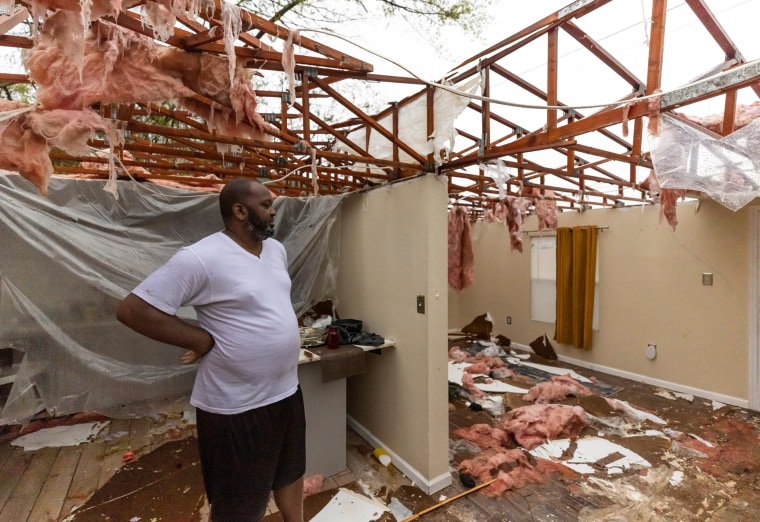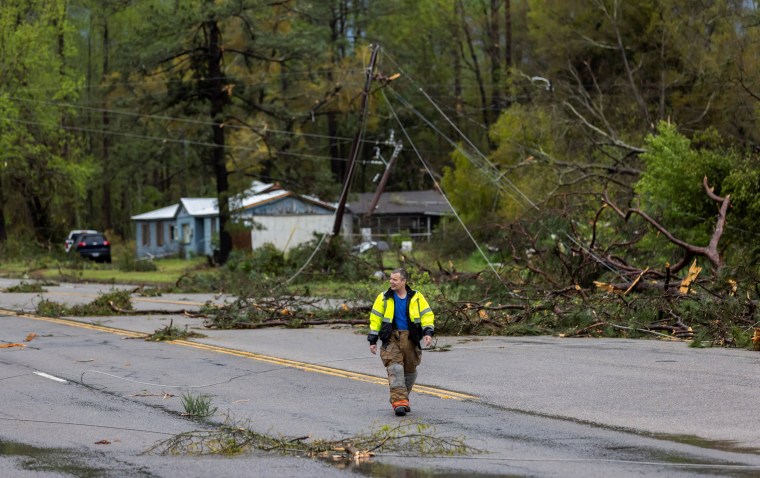For weeks now, storms have dumped dozens of inches of rain and brought a record-setting number of tornado reports to the southern United States, a seemingly unbreakable chain of severe weather that has left a trail of flooding, destruction and death from Texas to the Carolinas.
Last month set a record for most tornadoes reported during the month of March: 233. Many of them were across the South.
While it’s not unusual to see tornadoes and severe storms in the South at this time of year, it’s less common that such severe weather hits the same place over and over again, as has been the case this year.
The likely culprit is the mix of the effects of La Niña and a stalled weather pattern that is forcing multiple storms to take a similar path.

“We’ve got a relatively warm Gulf of Mexico, we’ve got an active La Niña ongoing, and we’re seeing these repetitive storm tracks continually emerge on a cadence of around every seven to 10 days,” said John Allen, an associate professor of meteorology with a focus on tornadoes at Central Michigan University. “Meaning that each week we’re getting these storm systems coming through. When that happens and if the ingredients can come together correctly, we will see quite a large number of tornadoes relative to perhaps what we’re used to.”
At least two people died Tuesday as two separate storm systems produced thunderstorms and apparent tornadoes in Alabama and South Carolina and put millions of people across several Southern states under risk for severe weather.
Over the weekend, bad weather forced airlines to cancel or delay thousands of flights, with JetBlue citing “severe weather in the Southeast” and Southwest blaming “weather and airspace congestion” for the disruptions, The Associated Press reported.
Last week, officials said two people were killed when a tornado touched down in the western Florida Panhandle. The same line of storms also injured people and damaged homes and businesses in Mississippi and Tennessee.
A week before that, an EF-3 tornado swept through the New Orleans-area community of Arabi, leaving at least one person dead in its 11-mile path of destruction.
“It was an extremely active month, unfortunately, from Texas eastward, across the Southeast U.S., and it shows no sign of abating,” said Bill Bunting, the chief of forecast operations at the National Oceanic and Atmospheric Administration’s Storm Prediction Center. “And we’re moving into the peak of tornado season, April and May.”
Last month already set the record for most tornado reports during the month of March, with 233. Reported tornadoes are those that have not yet been confirmed by the National Weather Service. The confirmed total number will be determined as on-the-ground surveys continue.
It’s not unusual to see tornadoes and severe storms in the Southern part of the country at this time of year, Bunting said. But what does not happen every year is that “areas that perhaps get hit with one round of storms can get hit again and again.”
“The atmosphere can get in these patterns that are persistent and repetitive, and hopefully we’ll see the end in sight,” Bunting said.
Next Monday through Wednesday, for instance, will likely feature another multiday round of severe storms across the central and southern Plains and parts of the Southeast, the fourth week in a row of severe storms across the southern tier of the U.S.
The storms are also being helped by La Niña, the naturally occurring weather pattern that historically has led to more severe weather across the South during the spring months.

“We’re in an ongoing La Niña pattern, which has persisted and is expected to persist at least for the next month, which tends to favor a more active development of low-pressure systems east of the Rockies,” Allen said. “Those systems tend to mean that you bring the ingredients together for tornadoes more frequently during La Niña conditions.”
La Niña conditions also contributed to the earlier start of the severe weather season, he said.
“We actually see it maybe a few weeks earlier than we would normally expect, which might explain what we saw in March,” Allen said.
Kathryn Prociv, a senior meteorologist for NBC News, said this week was the third in a row where “a multiday severe event has impacted the southern tier” and next week was looking like “another potential multiday event Monday to Wednesday.”
The two separate storm systems that began sweeping through the South on Tuesday are forecast to bring the risk of severe thunderstorms through Thursday. Tornadoes, large hail, damaging winds up to 75 mph and flash flooding are possible for the millions who will be in the storms’ path.
The threat Wednesday will affect many of the same areas hit Tuesday, including the metro areas of Atlanta; Birmingham, Alabama; Mobile, Alabama; Charleston, South Carolina; Tallahassee, Florida; and Jacksonville, Florida.
Allen said an active season means people are going to get a lot of weather warnings.
“Maybe those warnings don’t pan out for you individually, but you should always still take heed of those warnings and take shelter appropriately,” he said. “It only takes one tornado to damage your house and your livelihood and impact your life. The active season might mean that there are more tornadoes, but it only takes one tornado to cause significant impacts to people’s lives.”
Source: | This article originally belongs to Nbcnews.com









